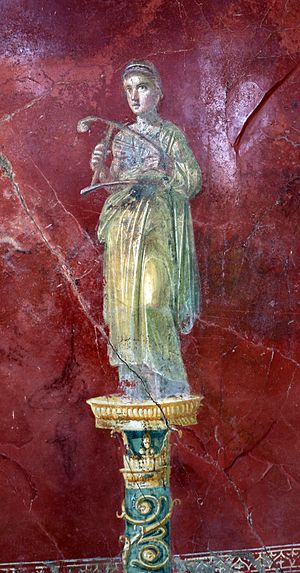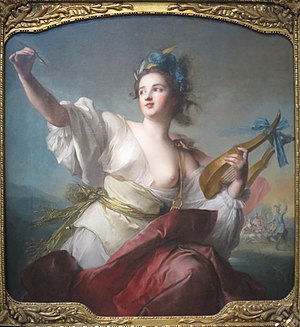Terpsichore
Jump to navigation
Jump to search
| Terpsichore | |
|---|---|
Goddess of Dancing and Chorus | |
| Member of the Muses | |
 | |
| Abode | Mount Olympus |
| Symbols | Lyre, plectrum |
| Personal information | |
| Parents | Zeus and Mnemosyne |
| Siblings | Euterpe, Polyhymnia, Urania, Clio, Erato, Thalia, Calliope, Melpomene, Aeacus, Angelos, Aphrodite, Apollo, Ares, Artemis, Athena, Dionysus, Eileithyia, Enyo, Eris, Ersa, Hebe, Helen, Hephaestus, Heracles, Hermes, Minos, Pandia, Persephone, Perseus, Rhadamanthus, the Graces, the Horae, the Litae, the Moirai |
| Consort | Apollo, Achelous, Ares |
| Children | Linus, Biston, the Sirens |

Terpsichore on an antique fresco from Pompeii
In Greek mythology, Terpsichore (/tərpˈsɪkəriː/; Τερψιχόρη, "delight in dancing") is one of the nine Muses and goddess of dance and chorus.[1] She lends her name to the word "terpsichorean" which means "of or relating to dance".
Appearance
Terpsichore is usually depicted sitting down, holding a lyre, accompanying the dancers' choirs with her music. Her name comes from the Greek words τέρπω ("delight") and χoρός ("dance").
Family
Tradition portrays Terpsichore as the mother of the Sirens (including Parthenope) by the river-god Achelous.[2] In some accounts, she bore the Thracian king Biston by Ares.[3] By another river-god, Strymon, Terpsichore mothered the Thracian king Rhesus.[4]
In popular culture

Terpsichore, Muse of Music and ballet, an oil on canvas painting by Jean-Marc Nattier (1739).
Historical
- The British 32-gun frigate HMS Terpsichore (1785) commanded by Captain Bowen participated in the Battle of Santa Cruz de Tenerife (1797).
Places
- Terpsichore is the name of a street in New Orleans' historic neighborhoods of Faubourg Lafayette and the Lower Garden District. It runs alongside Euterpe and Melpomene streets, also named for Greek muses.
- Terpsichorean is the name of the Choreography Society of Hans Raj College, University of Delhi.
- Terpsichore is the name of the Mississippi State University Dance Theatre Company in Starkville Mississippi.
Literature
- Terpsichore figures among her sisters in Hesiod's Theogony.
- When The Histories of Herodotus were divided by later editors into nine books, each book was named after a Muse. Terpsichore was the name of the fifth book.
- The character of Wilkins Micawber, Esq, Jr. is described as a "votary of Terpsichore", in an Australian newspaper brought to London by Dan Peggotty in 1850 novel David Copperfield by Charles Dickens.
- T. S. Eliot in the poem Jellicle Cats from Old Possum's Book of Practical Cats (1939), refers to the "terpsichorean powers'" Jellicle Cats as they dance by the light of the Jellicle Moon.
- Terpischore "Choral Dance" is the name of a chapter in Theresa Cha's Dictee.
- "Some Terpsichore" is the title of a short story in a 2014 book, Thunderstruck and Other Stories, by Elizabeth McCracken.
- Terpsichore is referenced in George Orwell's first novel Burmese Days (1934) in a dialogue by one of the minor characters, Mr. Macgegror.
- Terpsichore Station is the name of a mining facility in the Star Wars novel Phasma by Delilah S. Dawson
- Terpsichore is the immortal parent of Russian Jewish demigod Lavinia Asimov in Rick Riordan's Trials of Apollo series
Music and dance

Augustin Pajou, The Muse Terpsichore, c. 1768, red chalk on laid paper, in the collection of the National Gallery of Art, Washington, DC.
- Terpsichore (1612) is the title of a large collection of dance tunes collected by Michael Praetorius, some originating with Pierre-Francisque Caroubel and some later adapted for wind ensemble by Bob Margolis.
- Terpsichore is also found in François Couperin's "Second Ordre" from the Pièces de clavecin, and in the third version (HWV 8c) of Handel's opera Il pastor fido (1712). This opera is sometimes referred to as Terpsicore and Il pastor fido.
- Terpsichore is a role in George Balanchine's ballet Apollo.
- The eighteenth century French dancer and courtesan Marie-Madeleine Guimard named the private theater in her private palace (1766) the Temple of Terpsichore.
- The German-South African singer and composer Ike Moriz entitled his 2012 Jazz and Swing album "Siren Terpsichore" which includes his song of the same name.[5]
Media
- In the 1947 film Down To Earth, Rita Hayworth plays Terpsichore, who is annoyed and visits Earth to change a musical that depicts her in a bad light.[6]
- Olivia Newton-John plays the muse Terpsichore as "Kira" in the 1980 film Xanadu, a film inspied by Down To Earth.[7]
- Terpsichore is featured as a character in the 1997 Disney animated film Hercules. She appears in the Hercules animated series and plays an active role in the episode Hercules and the Muse of Dance, where she tutors Hercules on his dancing to pass in phys ed.
Science
- Terpsichore, a genus of ferns in the family Polypodiaceae, subfamily Grammitidoideae named after the Muse[8]
See also
- Muse
- Muses in popular culture
- The asteroid 81 Terpsichore
References
- ^ Theoi Project, Greek Mythology, Muses [1], Retrieved April 29, 2014
- ^ Apollonius of Rhodes, Argonautica 4.892; Nonnus, Dionysiaca 13.309; Tzetzes, Chiliades, 1.14, line 338 & 348
- ^ Etymologicum Magnum, 197. 59 s. v. Bistoniē
- ^ Eustathius on Homer, Iliad p. 817.
- ^ Siren terpsichore, 2012, OCLC 1253360564, retrieved 2021-09-16
- ^ "New Flower Named For Rita Hayworth". Pittsburgh Post-Gazette. Pittsburgh, Pennsylvania. August 29, 1946. p. 15. Retrieved May 2, 2016.
- ^ Ross, Robert Alan (August 23, 1980). "'Xanadu' is a pale imitation of old musicals". St. Petersburg Times. St. Petersburg, Florida. p. 5B. Retrieved May 2, 2016.
- ^ Smith, Alan R. (1993). "Terpsichore, a New Genus of Grammitidaceae (Pteridophyta)". Novon. 3 (4): 478–489. doi:10.2307/3391398. JSTOR 3391398.
External links
 Media related to Terpsichore at Wikimedia Commons
Media related to Terpsichore at Wikimedia Commons- Warburg Institute Iconographic Database (ca 40 images of Terpsichore)
Categories:
- Articles with short description
- Short description with empty Wikidata description
- Commons category link is defined as the pagename
- AC with 0 elements
- Greek Muses
- Music and singing goddesses
- Women of Ares
- Women of Apollo
- Children of Zeus
- Characters in Greek mythology
- Thraco-Macedonian mythology
- Dance in Greek mythology
- Metamorphoses characters
- Greek goddesses
- Dance goddesses
- Wisdom goddesses
- Music in Greek mythology